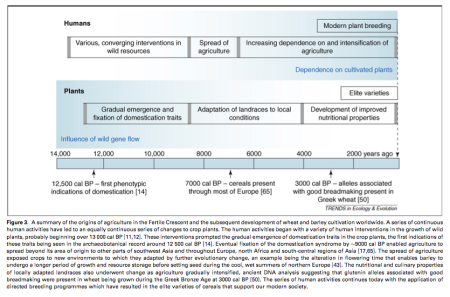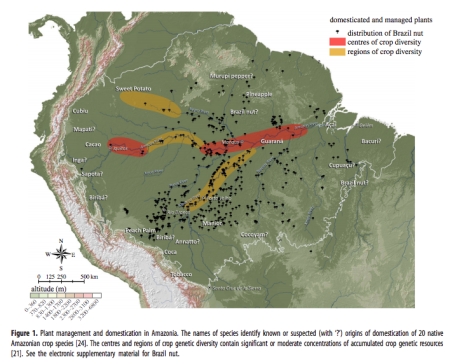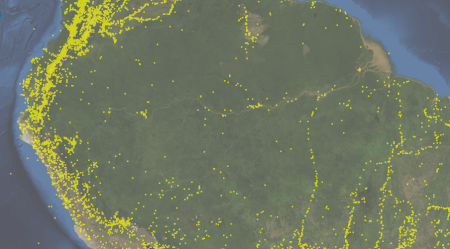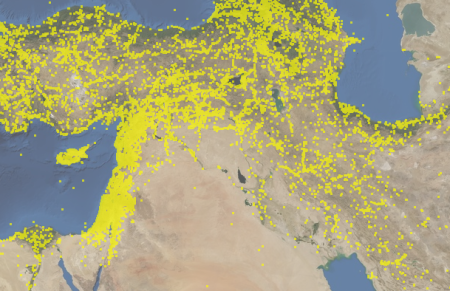- Secret of barley brittle rachis revealed. In other news, there’s a Centre of Excellence in Plant Cell Walls.
- Bramley apple pie filling protected. But from who?
- Participatively bred Oaxacan maize finds a market niche.
- Have some tequila with that participatively bred Oaxacan maize.
- “We can call a government and tell them our data is telling us that a pest is on the way.”
- The coolness of seeds.
- Yeah but “[g]ood seed in the wrong place is no longer good seed.”
Nibbles: Malagasy double, Sandwich photos, Middle way, NUS comms, Fishpocalypse, Cali palms, Home on the range, Heirloom rice, Potato genomes, Old watermelons
- Madagascar: Vintage photos, not-so-vintage photos.
- More photos, this time of state sandwiches. Yes, sandwiches.
- “The solutions to the problem of feeding people and protecting the planet are endlessly and irredeemably gray.” Pretty much the same argument I made recently, not quite so rudely.
- Training course on communicating the awesomeness of neglected species. How difficult can it be though, right?
- Keeping cats happy has a cost.
- Nifty vintage photos of California palms. The trees, people, the trees.
- Cowboys ain’t what they used to be. But only just.
- Gleaning deconstructed.
- IRRI opens exhibit on heirloom seeds, no doubt through gritted teeth.
- Ten potato genomes in the offing. Wait, doesn’t rice have like 3,000? Get it together, potato people.
- Renaissance watermelons looked really crappy. Probably tasted of something, though.
Early agriculture in the Old and New Worlds
Last week saw the publication of a couple of papers about early agriculture in two very different regions which will probably have people talking for quite a while. From Snir et al. 1 came a study of pre-Neolithic cultivation in the Near East. And from the other side of the world, there was the latest in the controversy over the extent of Amazonian agriculture from Clement et al. 2.
Yes, I did say pre-Neolithic. The key finding of the archaeological work described by the first paper is that 23,000 years ago, or over 11 millennia before the putative start of agriculture in the Fertile Crescent, hunter-gatherers along the Sea of Galilee in what is now Israel maintained little — and, crucially, weedy — fields of cereals. The archaeobotanists found remains of both the weeds and the cereals at a site called Ohalo II, as well as of sickles, and the cereals were not entirely “wild”, as the key domestication indicator of a non-brittle rachis was much more common than it should have been. To see what this means, have a look at this diagram from a fairly recent paper on agricultural origins in the region. 3

Those “first phenotypic indications of domestication”, dated at 12,500 years ago, need to be pushed quite a bit leftwards on that timeline now, off the edge in fact. A non-shattering rachis, it seems, was quite a quick trick for wild grasses to learn. But the process by which they acquired all the other traits that made them “domesticated” was very protracted and stop-start.
Zoom over to Amazonia, and the transition to farming took place much later, probably around 4,000 years ago, according to the other paper published last week. But it was just as significant as in the much better-known “cradle of agriculture” in the Fertile Crescent, with perhaps 80 species showing evidence of some domestication. The difference, of course, is that Amazonian agriculture was based on trees, rather than annual grasses and legumes.

According to the authors, parts of the Amazon basin, in particular those now showing evidence of earthworks and dark, anthropogenic soils, were just as much managed landscapes by the time of European contact as the places those Europeans came from. But compare our collections of crop diversity from the Amazon basin (courtesy of Genesys, which admittedly does not yet include Brazilian genebanks)…

with what we have from the Near East…

If we want to know more about how the domestication process and transition to agriculture differed in the Amazon and the Fertile Crescent, there’s a whole lot of exploration still to do.
Nibbles: High science, Methane-friendly rice, Gender, Indian priestesses, Banana extinction, Inka legacy, Diversity in ag, Yerba genome, Cucumber chains, Tomato relative, Agrobiodiversity in art
- High-level agricultural scientists thinks high agricultural science will feed the world. Oh, and smart policies.
- This new rice would qualify, I suspect.
- Participatory varietal selection manual revised to take women into account. Someone mention high science?
- No such manual needed in India, it seems.
- The banana-is-doomed story sure has legs. Or hands.
- What did the Inkas ever do for us?
- Is agriculture diverse enough? That is the question.
- Yerba mate gets sequenced. Because it can be.
- Following an Indian cucumber down the value chain.
- Thank your lucky stars for this weedy-looking tomato wild relative.
- “We’re interested in the color, shape and sizes of the vegetables from 400 years ago, compared to modern cultivars of the same vegetables: the deep sutures on cantaloupe in Italian art of the Renaissance or the lack of pigmentation in pictures of watermelon compared to today.”
- Quite a bit of agrobiodiversity featured in Day of Archaeology. Nice idea.
Nibbles: Oz vineyard apocalypse, California vineyards redux, Ethiopian genebank, Maya collapse revisionism, SunBlack tomato, Nutritious staples, Citrus endowment, Sheep pix
- In Australia, they’re ripping up vineyards.
- Whereas in California, they’re going to breed 10,000 new grape varieties and make a new wine. Go figure.
- Interview with the director of the Ethiopian national genebank, Dr Gemedo Dalle.
- Deforestation et al. not responsible for Maya collapse after all. Jared Diamond unavailable for comment.
- Black tomato a hit in Italy. Looks crap on pizza though.
- The case for biofortification.
- University of Florida sets up endowment to protect its research groves in face of citrus greening.
- Googlesheepview. Nuff said.